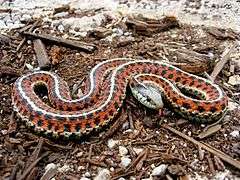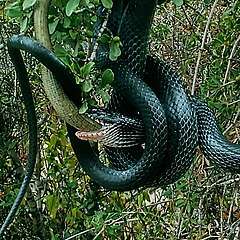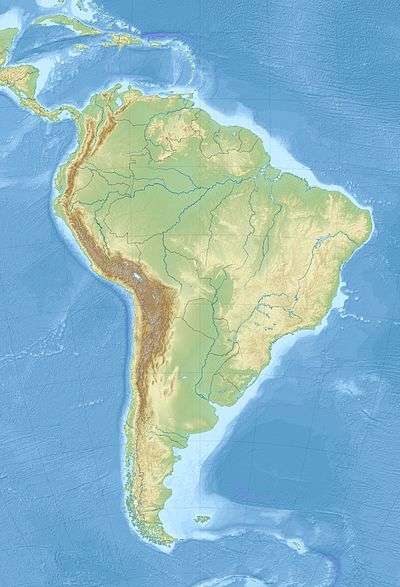Colubridae
Colubridae (/kəˈluːbrɪdiː/, commonly known as colubrids /ˈkɒljʊbrɪdz/, from Latin: coluber, 'snake') is a family of snakes. With 249 genera,[1] it is the largest snake family. The earliest species of the family date back to the Oligocene epoch. Colubrid snakes are found on every continent except Antarctica.[2]
| Colubridae Temporal range: Oligocene to recent | |
|---|---|
 | |
| Caspian whipsnake, Coluber caspius | |
| Scientific classification | |
| Kingdom: | Animalia |
| Phylum: | Chordata |
| Class: | Reptilia |
| Order: | Squamata |
| Suborder: | Serpentes |
| Superfamily: | Colubroidea |
| Family: | Colubridae Oppel, 1811 |
Description
While most colubrids are not venomous (or have venom that is not known to be harmful to humans) and are mostly harmless, a few groups, such as genus Boiga, can produce medically significant bites. In addition, the boomslang, the twig snakes, and the Asian genus Rhabdophis have caused human fatalities.[2][3][4]
Some Colubridae snakes are venomous, but not all are deadly. According to Scott Weinstein, author of "Venomous" Bites from Non-Venomous Snakes, more research needs to be done on the bites and venom of colubrids.[4] Some colubrids are described as opisthoglyphous (often called "rear-fanged"), meaning they have elongated, grooved teeth located in the back of their upper jaws. Opisthoglyphous dentition likely evolved many times in the history of snakes[3] and is an evolutionary precursor to the fangs of vipers and elapids, which are located in the front of the mouth.[5][6][7][2][3]
Classification
In the past, the Colubridae were not a natural group, as many were more closely related to other groups, such as elapids, than to each other.[8] This family was historically used as a "wastebasket taxon"[4] for snakes that do not fit elsewhere.[9] Until recently, colubrids were basically colubroids that were not elapids, viperids, or Atractaspis.[10]
However, recent research in molecular phylogenetics has stabilized the classification of historically "colubrid" snakes and the family as currently defined is a monophyletic clade,[11][12][13][14] although additional research will be necessary to sort out all the relationships within this group. As of May 2018, eight subfamilies are recognized.[15]
Current subfamilies
Sibynophiinae – 2 genera
Natricinae – 37 genera (sometimes given as family Natricidae)
.jpg)

- Adelophis
- Afronatrix
- Amphiesma
- Amphiesmoides
- Anoplohydrus
- Aspidura
- Atretium
- Clonophis
- Fowlea
- Haldea
- Hebius
- Helophis
- Herpetoreas
- Hydrablabes
- Hydraethiops
- Iguanognathus
- Isanophis
- Limnophis
- Liodytes
- Natriciteres
- Natrix
- Nerodia
- Opisthotropis
- Paratapinophis
- Pseudagkistrodon
- Regina
- Rhabdophis
- Rhabdops
- Smithophis
- Storeria
- Thamnophis
- Trachischium
- Trimerodytes
- Tropidoclonion
- Tropidonophis
- Virginia
- Xenochrophis
Pseudoxenodontinae – 2 genera
Dipsadinae – 99 genera (sometimes given as family Dipsadidae)
- Adelphicos
- Alsophis
- Amastridium
- Amnesteophis
- Apostolepis
- Arcanumophis
- Arrhyton
- Atractus
- Baliodryas
- Boiruna
- Borikenophis
- Caaeteboia
- Calamodontophis
- Caraiba
- Carphophis
- Cenaspis
- Cercophis
- Chersodromus
- Clelia
- Coniophanes
- Conophis
- Contia
- Coronelaps
- Crisantophis
- Cryophis
- Cubophis
- Diadophis
- Diaphorolepis
- Dipsas
- Ditaxodon
- Drepanoides
- Echinanthera
- Elapomorphus
- Emmochliophis
- Enuliophis
- Enulius
- Erythrolamprus
- Eutrachelophis
- Farancia
- Geophis
- Gomesophis
- Haitiophis
- Helicops
- Heterodon
- Hydrodynastes
- Hydromorphus
- Hydrops
- Hypsiglena
- Hypsirhynchus
- Ialtris
- Imantodes
- Leptodeira
- Lioheterophis
- Lygophis
- Magliophis
- Manolepis
- Mussurana
- Ninia
- Nothopsis
- Omoadiphas
- Oxyrhopus
- Paraphimophis
- Phalotris
- Philodryas
- Phimophis
- Plesiodipsas
- Pliocercus
- Pseudalsophis
- Pseudoboa
- Pseudoeryx
- Pseudoleptodeira
- Pseudotomodon
- Psomophis
- Ptychophis
- Rhachidelus
- Rhadinaea
- Rhadinella
- Rhadinophanes
- Rodriguesophis
- Saphenophis
- Sibon
- Siphlophis
- Sordellina
- Synophis
- Tachymenis
- Taeniophallus
- Tantalophis
- Thamnodynastes
- Thermophis
- Tomodon
- Tretanorhinus
- Trimetopon
- Tropidodipsas
- Tropidodryas
- Uromacer
- Urotheca
- Xenodon
- Xenopholis
Grayiinae – 1 genus
Calamariinae – 7 genera
Ahaetuliinae – 5 genera
Colubrinae – 92 genera

- Aeluroglena
- Aprosdoketophis
- Archelaphe
- Argyrogena
- Arizona
- Bamanophis
- Bogertophis
- Boiga
- Cemophora
- Chapinophis
- Chironius
- Coelognathus
- Coluber
- Colubroelaps
- Conopsis
- Coronella
- Crotaphopeltis
- Dasypeltis
- Dendrophidion
- Dipsadoboa
- Dispholidus
- Dolichophis
- Drymarchon
- Drymobius
- Drymoluber
- Eirenis
- Elaphe
- Euprepiophis
- Ficimia
- Geagras
- Gonyosoma
- Gyalopion
- Hapsidophrys
- Hemerophis
- Hemorrhois
- Hierophis
- Lampropeltis
- Leptodrymus
- Leptophis
- Liopeltis
- Lycodon
- Lytorhynchus
- Macroprotodon
- Masticophis
- Mastigodryas
- Meizodon
- Mopanveldophis
- Muhtarophis
- Oligodon
- Oocatochus
- Opheodrys
- Oreocryptophis
- Orientocoluber
- Oxybelis
- Palusophis
- Pantherophis
- Philothamnus
- Phrynonax
- Phyllorhynchus
- Pituophis
- Platyceps
- Pseudelaphe
- Pseudoficimia
- Ptyas
- Rhamnophis
- Rhinobothryum
- Rhinocheilus
- Rhynchocalamus
- Salvadora
- Scaphiophis
- Scolecophis
- Senticolis
- Simophis
- Sonora
- Spalerosophis
- Spilotes
- Stegonotus
- Stenorrhina
- Stichophanes
- Symphimus
- Sympholis
- Tantilla
- Tantillita
- Telescopus
- Thelotornis
- Thrasops
- Toxicodryas
- Trimorphodon
- Wallaceophis
- Xenelaphis
- Xyelodontophis
- Zamenis
Unknown incertae sedis (not currently placed in a subfamily, usually because of the absence of genetic data, but suspected to be colubrids based on morphology)
- Blythia
- Elapoidis
- Gongylosoma
- Lycognathophis
- Oreocalamus
- †Paraxenophis
- †Periergophis
- Poecilopholis
- Tetralepis
Former subfamilies
These taxa have been at one time or another classified as part of the Colubridae, but are now either classified as parts of other families, or are no longer accepted because all the species within them have been moved to other (sub)families.
- Subfamily Aparallactinae (now a subfamily of Lamprophiidae,[13] sometimes combined with Atractaspidinae)
- Subfamily Boiginae (now part of Colubrinae)
- Subfamily Boodontinae (some of which now treated as subfamily Grayiinae of the new Colubridae, others moved to family Lamprophiidae as subfamilies Lamprophiinae and Pseudaspidinae)
- Subfamily Dispholidinae (now part of Colubrinae)
- Subfamily Homalopsinae (now family Homalopsidae)[13]
- Subfamily Lamprophiinae (now a subfamily of Lamprophiidae)[13]
- Subfamily Lycodontinae (now part of Colubrinae)
- Subfamily Lycophidinae (now part of Lamprophiidae)
- Subfamily Pareatinae (now family Pareidae,[13] sometimes incorrectly spelled Pareatidae)[16]
- Subfamily Philothamninae (now part of Colubrinae)
- Subfamily Psammophiinae (now a subfamily of Lamprophiidae)[13]
- Subfamily Pseudoxyrhophiinae (now a subfamily of Lamprophiidae)[13]
- Subfamily Xenoderminae (now family Xenodermidae,[13] sometimes incorrectly spelled Xenodermatidae)[16]
- Subfamily Xenodontinae (which many authors put in Dipsadinae/Dipsadidae)
Fossil Colubridae
North America
- Mexico
| Find | NALMA | Formation | Notes | Refs |
|---|---|---|---|---|
| Colubrinae indet. | Pleistocene | Cueva de Abra Travertine | Described from Cueva de Abra Travertine in Tamaulipas by W. W. Dalquest and E. Roth. 1970. Late Pleistocene mammals from a cave in Tamaulipas, Mexico. Southwestern Naturalist 15(2):217-230 | [17] |
| ?Pituophis sp. | Blancan | Described from Las Tunas Wash; Jeffries Site in Baja California Sur by W. E. Miller. 1980. The Late Pliocene Las Tunas Local Fauna from Southernmost Baja California, Mexico. Journal of Paleontology 54(4):762-805 | [18] | |
| Lampropeltis intermedius | Blancan | Goleta | Described from locality in Michoacán by C. A. Repenning. 1962. The Giant Ground Squirrel Paenemarmota. Journal of Paleontology 36(3):540-556 | [19] |
South America
- Legend
| Find | SALMA | Basin | Formation | Country | Notes | Refs |
|---|---|---|---|---|---|---|
| "Colubridae sp." sic | Laventan | VSM | Villavieja | Described from same Los Mangos Fishbed in Huila; Colombophis portai and Eunectes stirtoni by R. Hoffstetter and J.-C. Rage. 1977. Le gisement de vertébrés Miocènes de La Venta (Colombie) et sa faune de serpents. Annales de Paléontologie (Vertébrés) 63(2):161-190 | [20] | |
| indet. | Chasicoan Mayoan Laventan | Solimões | Solimões | Described from Talismã, upper Purus River locality in Amazonas; the snakes Colombophis spinosus, aff. Epicrates sp., Eunectes sp. , the turtle Chelonoidis sp., crocodylians Acresuchus pachytemporalis and Caiman brevirostris, lizard cf. Paradracaena sp., and many mammals by Cozzuol, Mario Alberto. 2006. The Acre vertebrate fauna: Age, diversity, and geography. Journal of South American Earth Sciences 21. 185–203. Accessed 2017-08-15. | [21] | |
| Colubrinae indet. | Holocene | Subandean Belt | Ñuapua | Described from Ñuapua 2 locality in Chuquisaca; snakes Tupinambis teguixin, Boidae indet., Crotalidae indet., turtles, frogs Leptodactylus cf. ocellatus, Bufo cf. paracnemis, birds Crypturellus tataupa, Podiceps minor, Podiceps auritus cornutus, Platalea ajaja, Rhea cf. americana, Anas sp., Coccyzus sp., Dendrocygna sp., Jacana sp., Nyctibius sp., Platalea sp., cf. Rhynchotus sp., Columbidae indet., Falconidae indet., Passeriformes indet., Rallidae indet., fossils of Tolypeutus matacus, Ceratrophrys cf. ornata, and Leposternon sp., and many mammals including Homo sapiens by Marshall, Larry G., and Thierry Sempere. 1991. The Eocene to Pleistocene vertebrates of Bolivia and their stratigraphic context: A review. Revista técnica de YPFB 12. 631–652. Accessed 2017-08-15. | [22] | |
| indet. | Chapadmalalan | Sierras de Córdoba | Brochero | Described from Valle de Traslasierra - Paso del Río Arriba and Pedernara Cliffs locality in Córdoba; with Rhinella cf. arenarum, R. cf. spinulosa, Teius sp., ?Liolaemus sp., Iguanidae indet. and the mammals Chukimys favaloroi and Echimyidae indet. by L. E. Cruz, J. C. Fernicola, and C. A. Carignano. 2018. New Vertebrates of the Brochero Formation (Córdoba, Argentina): A Review of the Pliocene of Central Argentina. Journal of Mammalian Evolution 25:315-326 | [23] | |
| indet. | Chasicoan | Colorado | Cerro Azul | Described from Cerro La Bota locality in La Pampa; reported with many mammal fossils by Verzi, Diego H.; Claudia I. Montalvo, and Cecilia M. Deschamps. 2008. Biostratigraphy and biochronology of the Late Miocene of central Argentina: Evidence from rodents and taphonomy. Geobios 41. 145–155. Accessed 2017-08-15. | [24] | |
| indet. | Montehermosan | Claromecó | Monte Hermoso | From several localities in Buenos Aires; reported by R. L. Tomassini, C. I. Montalvo, C.M. Deschamps and T. Manera. 2013. Biostratigraphy and biochronology of the Monte Hermoso Formation (early Pliocene) at its type locality, Buenos Aires Province, Argentina. Journal of South American Earth Sciences 48:31-42 and C. M. Deschamps, G. I. Esteban, and M. S. Bargo. 2001. El registro más antiguo del género Lestodon Gervais, 1855 (Xenarthra, Tardigrada, Mylodontidae) (Montehermosense, Plioceno Temprano). Ameghiniana 38(2):151-156 | [25][26] [27][28] | |
| indet. | Colhuehuapian | Golfo San Jorge | Trelew Mb of Sarmiento | Described from same Gaiman locality in Chubut; Gaimanophis tenuis, Waincophis sp., the turtle Chelonoidis gringorum and many mammals by A. M. Albino. 1996. Snakes from the Miocene of Patagonia (Argentina) Part I: The Booidea. Neues Jahrbuch für Geologie und Paläontologie, Abhandlungen 199(3):417-434 | [29] | |
| indet. | Santacrucian | Austral | Rio Pinturas | From Río Pinturas locality in Santa Cruz; reported by A. M. Albino. 1996. Snakes from the Miocene of Patagonia (Argentina) Part II: The Colubroidea. Neues Jahrbuch für Geologie und Paläontologie, Abhandlungen 200(3):353-360 | [30] | |
| indet. | Santacrucian | Austral | Santa Cruz | Sole reptile described from Santa Cruz Formation locality in Santa Cruz together with the terror birds Psilopterus bachmanni, P. lemoinei, Phororhacos longissimus, Patagornis marshi, Brontornis burmeisteri, penguin Paraptenodytes antarcticus and other birds Eoneornis australis, Eutelornis patagonicus, Anisolornis excavatus, Protibis cnemialis, Opisthodactylus patagonicus, Liptornis hesternus, and many mammals by A. M. Albino. 1996. Snakes from the Miocene of Patagonia (Argentina) Part II: The Colubroidea. Neues Jahrbuch für Geologie und Paläontologie, Abhandlungen 200(3):353-360 & Vizcaíno, Sergio F.; Richard F. Kay, and Susana Bargo. 2012. Early Miocene Paleobiology in Patagonia: High-Latitude Paleocommunities of the Santa Cruz Formation, 1–370. Cambridge University Press ISBN 9780521194617. Accessed 2017-10-21.}} | [31][32] | |
References
- "Colubrid". britannica.com. Britannica. Retrieved 2 December 2018.
- Bauer, Aaron M. (1998). Cogger, H.G.; Zweifel, R.G. (eds.). Encyclopedia of Reptiles and Amphibians. San Diego: Academic Press. pp. 188–195. ISBN 0-12-178560-2.
- Bruna Azara, C. (1995). "Animales venenosos. Vertebrados terrestres venenosos peligrosos para el ser humano en España" (PDF). Boletín de la S.E.A. 11: 32–40.
- Weinstein, S. A.; Warrell, D. A.; White, J.; Keyler, D. E. (20 June 2011). "Venomous" bites from non-venomous snakes: A critical analysis of risk and management of "colubrid" snake bites. London: Elsevier. doi:10.1016/C2010-0-68461-6. ISBN 978-0-12-387732-1.
- Jackson, K (2003). "The evolution of venom-delivery systems in snakes" (PDF). Zoological Journal of the Linnean Society. 137 (3): 337–354. doi:10.1046/j.1096-3642.2003.00052.x. Archived from the original (PDF) on 2018-10-03. Retrieved 2018-05-13.
- Vonk, F. J.; Admiraal, J. F.; Jackson, K.; Reshef, R.; de Bakker, M. A.; Vanderschoot, K.; van den Berge, I.; van Atten, M.; Burgerhout, E.; Beck, A. (2008). "Evolutionary origin and development of snake fangs" (PDF). Nature. 454 (7204): 630–633. doi:10.1038/nature07178. PMID 18668106. Archived from the original (PDF) on 2018-04-13. Retrieved 2018-05-13.
- Fry, B. G.; Casewell, N. R.; Wüster, W.; Vidal, N.; Young, B.; Jackson, T. N. (2012). "The structural and functional diversification of the Toxicofera reptile venom system" (PDF). Toxicon. 60 (4): 434–448. doi:10.1016/j.toxicon.2012.02.013. PMID 22446061.
- Lawson, R.; Slowinski, J.B.; Crother, B.I.; Burbrink, F.T. (2005). "Phylogeny of the Colubroidea (Serpentes): New evidence from mitochondrial and nuclear genes" (PDF). Molecular Phylogenetics and Evolution. 37 (2): 581–601. doi:10.1016/j.ympev.2005.07.016. PMID 16172004. Archived from the original (PDF) on 2011-07-27. Retrieved 2010-12-08.
- Fry, B.G.; Vidal, N.; van der Weerd, L.; Kochva, E.; Renjifo, C. (2009). "Evolution and diversification of the Toxicofera reptile venom system". Journal of Proteomics. 72 (2): 127–136. doi:10.1016/j.jprot.2009.01.009. PMID 19457354.
- Pough, F. H.; Andrews, R. M.; Cadle, J. E.; Crump, M. L.; Savitzky, A. H.; Wells, K. (2004). Herpetology (3rd ed.). Upper Saddle River (NJ): Prentice Hall. p. 162. ISBN 0138508763.
- Pyron, R. A.; Burbrink, F.; Wiens, J. J. (2013). "A phylogeny and revised classification of Squamata, including 4161 species of lizards and snakes". BMC Evolutionary Biology. 13: 93. doi:10.1186/1471-2148-13-93. PMC 3682911. PMID 23627680.
- Figueroa, A.; McKelvy, A. D.; Grismer, L. L.; Bell, C. D.; Lailvaux, S. P. (2016). "A species-level phylogeny of extant snakes with description of a new colubrid subfamily and genus". PLOS ONE. 11 (9): e0161070. doi:10.1371/journal.pone.0161070. PMC 5014348. PMID 27603205.
- Pyron, R. A.; Burbrink, F. T.; Colli, G. R.; de Oca, A. N. M.; Vitt, L. J.; Kuczynski, C. A.; Wiens, J. J. (2011). "The phylogeny of advanced snakes (Colubroidea), with discovery of a new subfamily and comparison of support methods for likelihood trees" (PDF). Molecular Phylogenetics and Evolution. 58 (2): 329–342. doi:10.1016/j.ympev.2010.11.006. PMID 21074626.
- Zheng, Y; Wiens, JJ (2016). "Combining phylogenomic and supermatrix approaches, and a time-calibrated phylogeny for squamate reptiles (lizards and snakes) based on 52 genes and 4162 species" (PDF). Molecular Phylogenetics and Evolution. 94 (Pt B): 537–547. doi:10.1016/j.ympev.2015.10.009. PMID 26475614.
- Uetz, Peter. "Colubridae at The Reptile Database". The Reptile Database. EMBL. Retrieved 13 May 2018.
- Savage, Jay M. (2015). "What are the correct family names for the taxa that include the snake genera Xenodermus, Pareas, and Calamaria?". Herpetological Review. 46 (4): 664–665. Archived from the original on 2016-03-07. Retrieved 2018-05-14.
- Fossilworks
- Fossilworks
- Fossilworks
- Fossilworks
- Fossilworks
- Fossilworks
- Fossilworks
- Fossilworks
- Fossilworks
- Fossilworks
- Fossilworks
- Fossilworks
- Fossilworks
- Fossilworks
- Fossilworks
- Fossilworks
Bibliography
- Barbière, Franck; Pablo E. Ortiz, and Ulyses F.J. Pardiñas. 2018. The oldest sigmodontine rodent revisited and the age of the first South American cricetids. Journal of Paleontology Online edition. _. Accessed 2019-02-11.
- Barbière, Franck; Laura E. Cruz; Pablo E. Ortiz, and Ulyses F. J. Pardiñas. 2016. A new genus of Sigmodontinae (Mammalia, Rodentia, Cricetidae) from the Pliocene of Central Argentina. Journal of Vertebrate Paleontology 36. e1199557. Accessed 2019-02-12.
- Nicoli, Laura. 2015. New fossil species of the extant genus Lepidobatrachus (Anura, Ceratophryidae) from the Late Miocene-Early Pliocene of central Argentina. Journal of Vertebrate Paleontology 35. e981636. Accessed 2019-02-13.
- Agnolin, Federico L.; Sergio Bogan; Rodrigo L. Tomassini, and Teresa Manera. 2014. Nuevo Percichthyidae (Teleostei, Percoidei) del Plioceno temprano de la provincia de Buenos Aires (Argentina) y sus implicancias biogeográficas. Revista del Museo de Ciencias Naturales 16. 19–31. Accessed 2018-09-10.
- Zamorano, Martin. 2013. Diagnosis y nueva descripción de Propanochthus bullifer (Burmeister) (Xenarthra, Glyptodontidae). Consideraciones bioestratigráficas y cronológicas de su procedencia. Spanish Journal of Palaeontology 28. 283–292. Accessed 2018-09-10.
- Vizcaíno, Sergio F.; Richard F. Kay, and Susana Bargo. 2012. Early Miocene Paleobiology in Patagonia: High-Latitude Paleocommunities of the Santa Cruz Formation, 1–370. Cambridge University Press ISBN 9780521194617. Accessed 2017-10-21.
- Albino, Adriana M.; Tomassini Rodrigo, and Santiago Brizuela. 2009. Presencia del lagarto teiido Tupinambis en la FormaciónMonte Hermoso de Farola Monte Hermoso, sur de la provincia de Buenos Aires (Argentina). Ameghiniana 46. 177–187. Accessed 2018-09-10.
- Bogan, Sergio, and Federico L. Agnolin. 2009. Primer registro fósil de la familia Trichomycteridae (Teleostei: Siluriformes; Plioceno) en la Formación Monte Hermoso, Argentina. Revista del Museo de Ciencias Naturales 11. 193–198. Accessed 2018-09-10.
- Verzi, Diego H.; Claudia I. Montalvo, and Cecilia M. Deschamps. 2008. Biostratigraphy and biochronology of the Late Miocene of central Argentina: Evidence from rodents and taphonomy. Geobios 41. 145–155. Accessed 2017-08-15.
- Cozzuol, Mario Alberto. 2006. The Acre vertebrate fauna: Age, diversity, and geography. Journal of South American Earth Sciences 21. 185–203. Accessed 2017-08-15.
- Marshall, Larry G., and Thierry Sempere. 1991. The Eocene to Pleistocene vertebrates of Bolivia and their stratigraphic context: A review. Revista técnica de YPFB 12. 631–652. Accessed 2017-08-15.
.jpg)

